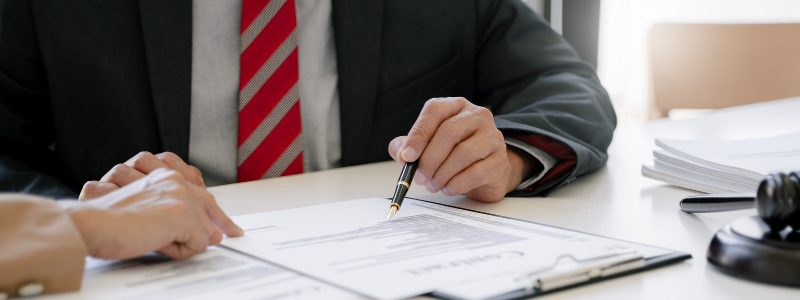Experiencing an accident of any kind can be traumatic. Unfortunately, accidents – especially those that involve vehicle collisions, at-work injuries, medical malpractice, and others – involve so many factors that it’s not always clear how to navigate what happens next. In some cases, people may advise retaining a personal injury lawyer to explore viable options for compensation. But in some circumstances, you may be faced with another scenario altogether: what happens when a personal injury claim is filed against me?
Being on the receiving end of a lawsuit can pose significant obstacles and raise concern of what – in the worst case scenario – can happen. For clarity, a personal injury attorney can offer guidance. You may think that accident or injury lawyers only help people who are innocent victims. However, there are many ways an attorney can assist you even if you think you’re at fault. It is always worth it to discuss the situation with an Oregon law firm that regularly handles accident and injury cases.

What is a Personal Injury Claim?
A personal injury claim occurs when a person who has experienced injuries in a car accident, a slip-and-fall mishap, or a work-related injury sues for damages against one or more parties in a civil court.
Personal injury suits usually have two issues:
- Who is liable for damages?
- What are the damages?
Damages that are Considered Personal Injury
Damages are injury-related losses. These may include any or all of:
- Pain and suffering
- Loss of quality of life
- Expenses not covered by insurance
- Lost income
- Decrease in earning capacity in the future
- Future care costs
- Legal costs
Personal Injury Claims Process
If you have been sued in a personal injury claim, this is what you can expect. The claimant will launch a lawsuit for personal injury damages. This will include fact-finding regarding how the accident occurred. Both sides will try to gain an understanding of the claimant’s injuries. They will also delve into the person’s background, medical history, the harm endured, and what is required for recovery.
At this point, the Statement of Claim will be prepared by the claimant.
How to properly handle an accident or an event that leads to injury?
Whether or not you believe you’re at fault for an incident that results in injury, it’s important to know how to conduct yourself to ensure your protection at every level. First, after an accident or injury occurs it’s critical to ensure your safety first. Seeking medical attention for sustained injuries is a top priority. In the case of car accidents, it’s crucial that you remain at the scene of the accident as most states have laws against leaving, which can work against you in later legal proceedings.
In some situations, other parties may become aggressive or confrontational. Do your best to stay grounded and try not to admit to fault or even apologize for what’s occurred. Many individuals make the mistake of apologizing for not paying attention or being distracted. Admitting to negligent acts can result in having a personal injury claim filed against you. In general you should avoid doing the following:
- Discuss particulars for what you were doing prior to the event
- Speaking on who you think was to blame
- Apologizing or making statements that may indicate you were at fault
- Asking the other party questions to inquire if they believe you were at fault
Question: there’s been a personal injury claim filed against me, what do I do?
Personal Injury Claim Filed Against Me
Navigating the law can be incredibly taxing. However, it’s essential to understand how injured drivers obtain different means of compensation. Especially as a defendant, this knowledge becomes invaluable because it can assist you in understanding what you, your insurance company, or another party is responsible for. Bodily injury liability and personal injury claims are two ways that a plaintiff receives compensation following an accident.
Fault-based states assign fault ratings to both parties following an accident. In many states, only the driver with a fault rating of less than 50% can claim damages from the other driver. Oregon law follows a traditional fault-based system. An experienced personal injury attorney can help verify if you’re actually entitled to compensation, even if you’ve had a claim already filed against you.
It’s crucial that proper paperwork is filed appropriately. Timelines must be met. If the claim against you does not follow the proper claims process, the claim may end up costing you millions of dollars.
Discoveries are followed by both lawyers. In this process, each side questions the other side about what happened. Discoveries provide an opportunity to quantify damages and understand liability.
These are all tasks better handled by qualified, experienced legal counsel.
What is “At Fault” in a Car Accident?
Regardless of how mild or severe a vehicle accident is, one or more drivers will be determined to be at fault.
Sometimes the “at fault” driver who caused the accident is obvious. At other times the situation is more complicated.
Assigning who is at fault is highly subjective. Rules and laws vary not only from one state to another but from insurance company to insurance company.
How Police Determine who is to Blame for Car Injury Cases
When an accident occurs, it is important to call the police. They are qualified to conduct road accident investigations and to determine who is at fault. Be sure to get a copy of the police report. Police investigate. Then, officers prepare an accident police report. This describes the details of the accident.
Officers interview drivers and witnesses. Based on accident damage, what they learned from witnesses, and any camera footage, they attempt to determine an accurate account of what happened. The police report may contain a statement about fault for the accident based on their professional judgment.
Not all police reports assign an “at fault” driver. Even where the “at-fault” designation is stated, this doesn’t mean that the driver will be held legally “at-fault” in a lawsuit.

Negligence – Personal Injury Claims
If there is negligence, a police officer may issue a traffic citation. The citation does not prove legal responsibility for the accident. However, it may be used as evidence of driver negligence by the insurance companies.
Thanks to modern technology, determining who is at fault in automobile accidents is easier than ever. Often, the nature and extent of the damages sustained by one or more vehicles can determine fault. For example, if a vehicle sustained rear-end damage in a car crash, this is usually caused by the driver who was behind that car. But, in a multiple-car pileup, who is at fault can be very hard to determine.
Witness reports are also important. Just because a driver has violated a traffic code which caused or contributed to an accident, it doesn’t mean he/she will admit to it. At-fault drivers frequently deny causing an accident.
In complicated accidents, a team of qualified accident reconstruction specialists may be called in to prepare a report.
How do Insurance Companies Determine at Fault?
In the final analysis, the insurance company decides who is at fault and, thus, who pays. This can be further complicated by insurance company guidelines and state “at-fault” and “no-fault” designations. Every insurance company handles what is covered and what is not covered differently.
When an accident occurs, drivers file a claim with their insurance company. Then, the insurance company assigns this claim to one of its adjusters. It is the job of the adjuster to handle the investigation and then to settle the claim. More than one adjuster will be involved if there was more than one driver and/or more than one insurance company involved.
Adjusters can execute the following:
- Research the car accident
- Talk to witnesses
- Access medical reports
- Photograph vehicle damage
- Verify details of the insurance policy of the driver involved
The adjusters decide based on their research who was “at-fault” in the accident. Sometimes this may be a percentage fault to more than one driver. Adjusters base their determination on negligence as defined by the state. Negligent drivers have failed to use the amount of caution one would expect from a reasonable person given the circumstances.
No-Fault versus at-Fault States
Some states are “no-fault” states. Others are “fault” states.
In “no-fault” states, the driver involved in an accident deals with the auto insurance company for coverage of all medical expenses and vehicle repairs whether or not he is the one who caused the collision.
In “at-fault” states, insurance companies investigate who caused the crash. The “at-fault” driver’s insurance company is responsible for all damages and medical expenses.
Drivers who were not found to blame may have to sue the insurance company of the “at-fault” driver for damages in “at-fault” states.
Disputing “At-Fault” Claims
If you believe that you were not totally at fault, there are steps you can take to dispute this claim. First, you need to inform your insurance company by written communication or by phone that you are disputing the ruling that you were at fault or that your actions caused the collision.
Ultimately, if you do not get resolution of your claim, you can appeal the at-fault determination to the Board of Appeal.
In any case of disputing an at-fault claim, you are wise to have an experienced lawyer who knows how to deal with personal injury claims.
Best Way to Protect Yourself After an Accident
Ideally, I’d like to say that I had never had a personal injury claim filed against me. This is everyone’s dream. There are steps you can take to protect yourself from a false “at-fault” claim.
Report the accident.
Regardless of the severity, report the collision. That way you have a police report witness statements for your insurance company.
Keep accurate accident records.
Get the names and contact information of the police, witnesses, and others involved in the accident. Take photographs of the scene yourself. Include road conditions, signs, and traffic signals. Note the location of the vehicles and vehicle damage.
Take notes about what happened so it is fresh in your mind.
Hiring an Injury Attorney to Fight False Claims
Car accident claims are complicated and messy. Lawsuits can be challenging. They are even more challenging if you are fighting a false “at-fault” claim. Don’t attempt to do this on your own.
Hire a lawyer who specializes in accident claims. Knowledgeable accident injury claims lawyers provide valuable legal advice. It is crucial to protect your legal rights. A personal injury claim filed against me, what do I do? Contact Oregon injury attorney Ryan Hilts to schedule a consultation.


